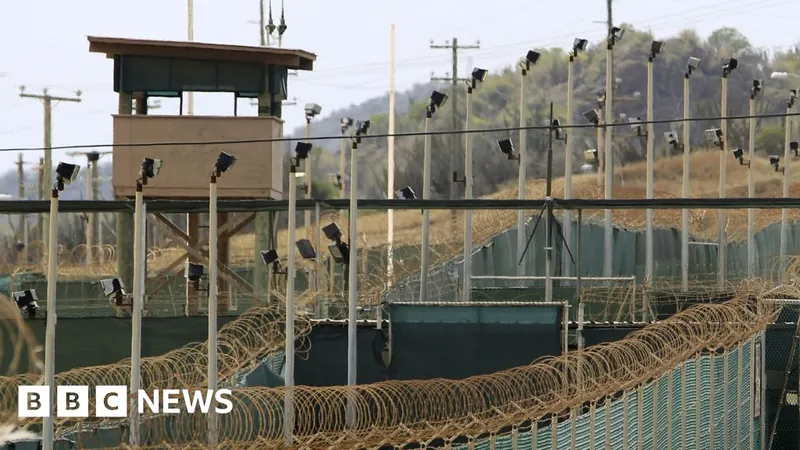
Historic Transfer: 11 Detainees Released from Guantanamo Bay to Oman Amid Ongoing Legal Battles
2025-01-07
Author: Lok
Historic Transfer: 11 Detainees Released from Guantanamo Bay to Oman Amid Ongoing Legal Battles
In a significant humanitarian and diplomatic move, eleven Yemeni detainees have recently been transferred from the notorious Guantanamo Bay military prison to Oman. This action marks a pivotal moment in the ongoing efforts to reduce the detainee population at the facility, now housing only 15 individuals – the lowest number since its establishment.
The U.S. Department of Defense issued a statement expressing gratitude to Oman for its cooperation in assisting the United States' strategy to responsibly decrease the detainee count and ultimately shut down the prison. This transfer is particularly notable as none of these detainees were ever charged with any crime during their more than two decades of confinement, a situation that has drawn significant scrutiny and highlighted concerns regarding human rights and legal justice.
The timing of this transfer is especially remarkable, occurring just days before a key figure involved in the September 11 attacks, Khalid Sheikh Mohammed, is set to plead guilty as part of a negotiated deal with federal authorities to avoid the death penalty. This coincidence underscores the complexities surrounding the legal processes for detainees at Guantanamo Bay.
This operation represents the largest number of detainees transferred in one go during President Joe Biden's administration. Efforts to resettle these detainees in Oman have been underway for several years, primarily due to the unstable conditions in Yemen, which is currently engulfed in a devastating civil war. The transfer also follows the recent repatriation of Ridah Bin Saleh al-Yazidi, one of the original detainees since January 2002, who was returned to Tunisia just a week prior.
Among those transferred are notable figures such as Moath al-Alwi, who gained recognition for his creative spirit, crafting model boats from found objects in the prison. Another detainee, Shaqawi al Hajj, became known for his hunger strikes protesting his prolonged detention. Both men had been cleared for release by national security review panels, which concluded their transfer was in line with U.S. national security interests.
It’s worth mentioning that the Guantanamo Bay facility was established by the Bush administration in 2002, following the 9/11 attacks, to detain individuals viewed as threats in counter-terrorism efforts. At its peak, the prison held around 800 detainees, but it has faced allegations of torture and inhumane treatment, sparking an ongoing debate about its legality and moral implications.
Former President Barack Obama made significant attempts to close Guantanamo during his administration, citing its existence as a violation of American values and a detriment to the nation's global standing. However, he faced considerable opposition from Congress, which limited options for the transfer of detainees and prevented the closure of the facility entirely.
The landscape of Guantanamo's future remains uncertain as President Biden aims to continue reducing the detainee population, though challenges persist due to congressional restrictions and the looming potential of a Trump presidency reinstating harder stances towards the facility.
As the United States navigates complicated legal and humanitarian waters, the recent transfer of these detainees serves as both a glimmer of hope for those involved and a reminder of the broader implications of the Guantanamo Bay saga. The world watches closely as history unfolds around this controversial detention center and the lasting impact it holds on American democracy and legal principles.


 Brasil (PT)
Brasil (PT)
 Canada (EN)
Canada (EN)
 Chile (ES)
Chile (ES)
 Česko (CS)
Česko (CS)
 대한민국 (KO)
대한민국 (KO)
 España (ES)
España (ES)
 France (FR)
France (FR)
 Hong Kong (EN)
Hong Kong (EN)
 Italia (IT)
Italia (IT)
 日本 (JA)
日本 (JA)
 Magyarország (HU)
Magyarország (HU)
 Norge (NO)
Norge (NO)
 Polska (PL)
Polska (PL)
 Schweiz (DE)
Schweiz (DE)
 Singapore (EN)
Singapore (EN)
 Sverige (SV)
Sverige (SV)
 Suomi (FI)
Suomi (FI)
 Türkiye (TR)
Türkiye (TR)
 الإمارات العربية المتحدة (AR)
الإمارات العربية المتحدة (AR)